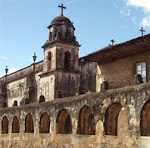A friend of mine in Patzcuaro, I will call her FP, unfortunately has contracted H. Pylori which has resulted in a bleeding ulcer. She also has some enlarged lymph nodes that have suspicious cells. Her housekeeper, call her Maria, is very concerned for FP, and yesterday Maria explained to her that she can be totally cured of the H. Pylori as well as any latent cancer by a natural cure that is purported to cure even a late diagnosis leukemia.
It seems that in a pueblo called Santa Ana, not on the way to Erongaricuaro but farther away where men live in a hill cave, the Purhépechas collect what is needed for this miracle cure and come into Patzcuaro to sell their remedies. The cure consists of two different food dishes and you must eat both (not necessarily at the same time). The first is a stew made of serpiente de cascabel (rattlesnake) and the second a stew made with tuza, a mole. The mole is believed to be a very clean animal because it eats only specific plant roots, and it is also thought to be highly nutritious. Veggies, rice, pasta, potatoes, beef, or chicken, etc. can be added to the stews, but never pork or chiles.

Maria wanted to immediately have the Santa Ana gatherers procure the requisite moles and snakes (cleaned and dressed, by the way) for today. FP thought she had tactfully postponed this therapy by saying she wants to first finish her fourteen-day "mega antibiotic" treatment. But the response was that the stews do not interfere with regular (allopathic) medicines, and that she should proceed immediately. For someone who has not been able to eat much of anything because of an ulcer, it would seem that right now eating-therapy would be problematic. However, because Maria wants so much to help, FP dutifully ordered moles and snakes. Her taste buds are tingling in anticipation. She will have her housekeeper do the stewing.
 Last week FP was given another tip: drink "potato water". Agua de papas is made by dicing or grating whole potatoes, skin and all, and soaking them in water for several hours. One then drains off the water and saves it in a large container. Drink one glass each morning. FP's husband makes the dirty-looking water for her--and then fries up delicious hash browns for himself. Another Patzcuaro friend claims the water soothes the stomach better than any modern product and that he himself was cured of a serious bleeding ulcer by potato water only. Good news: FP reports that the agua does indeed soothe her stomach lining, whereas Nexium did nothing.
Last week FP was given another tip: drink "potato water". Agua de papas is made by dicing or grating whole potatoes, skin and all, and soaking them in water for several hours. One then drains off the water and saves it in a large container. Drink one glass each morning. FP's husband makes the dirty-looking water for her--and then fries up delicious hash browns for himself. Another Patzcuaro friend claims the water soothes the stomach better than any modern product and that he himself was cured of a serious bleeding ulcer by potato water only. Good news: FP reports that the agua does indeed soothe her stomach lining, whereas Nexium did nothing.
Much of the tourism to Patzcuaro is by devout mexicanos who come on a pilgrimage to petition Nuestra Señora de la Salud (Our Lady of Health), the pueblo's patron saint, for healing. In front of the Basílica, every day vendors sell folk cures for ailments from arthritis to kidney troubles. The daily market also sells many kinds of medicinal herbs. FP feels genuinely touched by the sincere care and concern that people in Patzcuaro have shown her, which includes recommending the remedies in which they believe and on which there is much focus.
PS - If the next time I eat with FP she serves stew, it will be suspect.
Patzcuaro bound?


.JPG)














